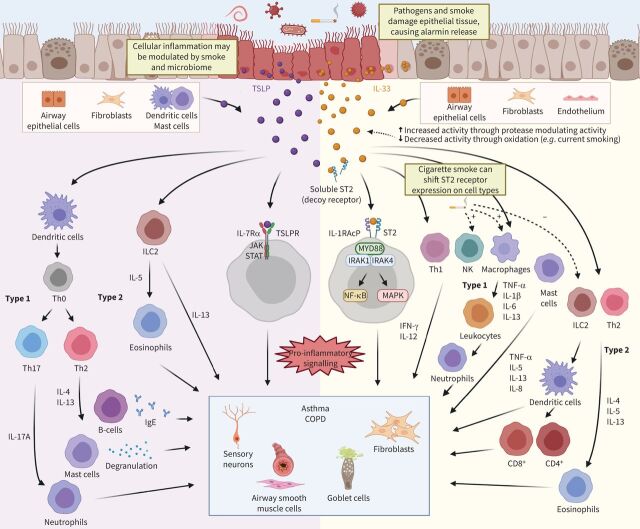FIGURE 1.
Interleukin (IL)-33 and thymic stromal lymphopoietin (TSLP) pathways in asthma and COPD. In response to insults to the airway epithelium, the alarmins IL-33 and TSLP are released from damaged epithelial cells, although other sources of the alarmins also exist. The alarmin IL-25 (not pictured here) is also released upon epithelial damage and has shown to induce type 2 (T2) inflammation and eosinophilia. IL-33 promotes inflammation through binding to its receptor, ST2 (IL1RL1), which is present on multiple cells including neutrophils, eosinophils, macrophages, basophils and mast cells, resulting in the production of both T2 and non-T2 cytokines. Binding of IL-33 to the ST2 receptor results in activation of downstream mitogen-activated protein kinase (MAPK) and NF-κB signalling. A decoy, soluble form of the ST2 receptor acts as a negative regulator of IL-33 activity. Full-length IL-33 can undergo cleavage from different proteases (e.g. neutrophil elastase), which can produce shorter isoforms that can either enhance or reduce IL-33 activity. Cigarette smoke has been shown to shift the type of immune response to IL-33, limiting the T2 while leading to an exaggerated T1 response. TSLP has a broad immune effect, activating multiple cell types and resulting in the production of cytokines typically associated with a T2 response, while also affecting mast cells, T-helper (Th) 1 cells, and other cells that result in the production of both T2 and non-T2 cytokines. TSLP signals through its receptor, TSLPR, to activate downstream Janus kinase (JAK)/signal transducer and activator of transcription (STAT) pathways with the absence of any decoy TSLPR. IL-33 and TSLP inflammatory pathways ultimately result in changes to the nonimmune components of the lung microenvironment, such as smooth muscle contraction/hyperreactivity (both), goblet cell mucus production (both), fibroblast activation (IL-33) and sensory neurons (TSLP), which contributes to the clinical symptoms and traits of asthma and COPD. Figure created using BioRender.com. IgE: immunoglobulin E; IRAK: IL-1 receptor-associated kinase; MYD88: myeloid differentiation primary response gene 88; NK: natural killer; TNF-α: tumour necrosis factor α.

